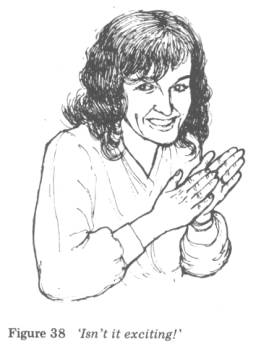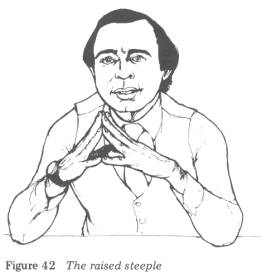Body Language: How to Read Others' Thoughts by Their Gestures (6 page)
Read Body Language: How to Read Others' Thoughts by Their Gestures Online
Authors: Allan Pease
Tags: #Popular psychology, #Advice on careers & achieving success, #Psychology


The intention of the double-handed handshake is to show sincerity, trust or depth of feeling towards the receiver. Two significant elements should be noticed. Firstly, the left hand is used to communicate the extra feeling that the initiator wishes to transmit and its extent is related to the distance that the initiator’s left hand is moved up the receiver’s right arm. The elbow grasp, for example (Figure 35), transmits more feeling than the wrist hold (Figure 34), and the shoulder hold, (Figure 37) transmits more than the upper-arm grip (Figure 36). Secondly, the initiator’s left hand represents an invasion of the receiver’s intimate and close intimate zones. In general, the wrist hold and the elbow grasp are acceptable only between close friends or relatives and in these cases, the initiator’s left hand penetrates only the receiver’s intimate zone. The shoulder hold (Figure 37) and the upper arm grip (Figure 36) enter the receiver’s close intimate zone and may involve actual body contact. They should be used only between people who experience a close emotional bond at the time of the handshake. Unless the extra feeling is mutual or the initiator does not have a good reason for using a double-handed handshake, the receiver will become suspicious and mistrust the initiator’s intentions. It is quite common to see politicians greeting voters and sales people meeting their new customers with a double-handed hand shake without realising that this can be social suicide, putting the receiver off-side.

Four
Hand and Arm Gestures
HAND GESTURES
Rubbing the palms together
Recently a personal friend of ours visited my wife and me at our home to discuss the details of a forthcoming skiing holiday. In the course of the conversation our friend suddenly sat back in her chair, smiled broadly, rubbed her palms together and exclaimed, ‘I can hardly wait to go!’ Non-verbally she had told us that she expected the trip to be a big success.
 Rubbing the palms together is a way in which people non-verbally communicate positive expectation. The dice thrower rubs the dice between his palms as a sign of his positive expectancy of winning, the master of ceremonies rubs his palms together and says to his audience, ‘We have long looked forward to hearing our next speaker’, and the excited sales person struts into the sales manager’s office, rubs his palms together and says excitedly, ‘We’ve just got a big order, boss!’ However, the waiter who comes to your table at the end of the evening rubbing his palms together and asking, ‘Anything else, sir?’ is non-verbally telling you that he is expecting a tip.
Rubbing the palms together is a way in which people non-verbally communicate positive expectation. The dice thrower rubs the dice between his palms as a sign of his positive expectancy of winning, the master of ceremonies rubs his palms together and says to his audience, ‘We have long looked forward to hearing our next speaker’, and the excited sales person struts into the sales manager’s office, rubs his palms together and says excitedly, ‘We’ve just got a big order, boss!’ However, the waiter who comes to your table at the end of the evening rubbing his palms together and asking, ‘Anything else, sir?’ is non-verbally telling you that he is expecting a tip.
The speed at which a person rubs his palms together signals whom he thinks will receive the positive results that are expected. Say, for example, you want to buy a home and you go to see a real estate agent. After describing the property you are seeking, the agent rubs his palms together quickly and says, ‘I’ve got just the right place for you!’ The agent has signalled that he expects the results to be to your benefit. But how would you feel if he rubbed his palms together very slowly as he told you that he had the ideal property? He would then appear to be crafty or devious and would give you the feeling that the expected results would be to his advantage rather than yours. Sales people are taught that if they use the palm rub gesture when describing products or services to prospective buyers, they should be certain to use a fast hand action to avoid putting the buyer on the defensive. When the buyer rubs his palms together and says to the sales person, ‘Let’s see what you have to offer!’ it is a signal that the buyer is expecting to be shown something. good and is likely to make a purchase.
A word of warning: a person who is standing at a bus terminal in freezing winter conditions and who rubs his palms together briskly may not necessarily be doing this because he is expecting a bus. He does it because his hands are cold!

Thumb and Finger Rub
Rubbing the thumb against the fingertips or against the index finger is commonly used as a money expectancy gesture. It is often used by sales people who rub their fingertips and thumb together and say to their customers ‘I can save you 40 per cent’, or the person who rubs his index finger and thumb together and says to his friend, ‘Lend me ten dollars’. This is obviously a gesture that should be avoided at all times by a professional person when dealing with his clients.
 Hands Clenched Together
Hands Clenched Together
At first this seems to be a confidence gesture as some people who use it are often smiling and sound happy. However, on one particular occasion, we saw a sales person describing the sale he had just lost. As he went further and further into his story, we noticed that not only had he taken the hands-clenched position, but his fingers were beginning to turn white and they looked as though they were welding together. This was therefore a gesture showing a frustrated or hostile attitude.
Research by Nierenberg and Calero on the hands-clenched position brought them to the conclusion that this was a frustration gesture, signalling that the person was holding back a negative attitude. The gesture has three main positions; hands clenched in front of the face, (Figure 39), hands resting on the desk (Figure 40) or on the lap when seated and placed in front of the crotch when standing (Figure 41).
There also appears to be a correlation between the height at which the hands are held and the strength of the person’s negative mood; that is, the person would be more difficult to handle when the hands are held high as in Figure 39 than he would be with the Figure 40 position. Like all negative gestures, some action needs to be taken to unlock the person’s fingers to expose the palms and the front of the body, or the hostile attitude will remain.


Steepling Hands
I stated at the beginning of this book that gestures come in clusters, like words in a sentence, and that they must be interpreted in the context in which they are observed. ‘Steepling’, as Birdwhistell called it, can be an exception to these rules, as it is often used in isolation of other gestures. In fact, people who are confident, superior types or who use minimal or restricted body gestures often use this gesture, and, by doing so, they signal their confident attitude.
My observation and research into this fascinating gesture show that it is frequently used in superior/subordinate interaction and that it can be an isolated gesture which indicates a confident or ‘know-it-all’ attitude. Managers often use this gesture position when giving instructions or advice to subordinates and it is particularly common among accountants, lawyers, managers and the like.
The gesture has two versions; the raised steeple (Figure 42), the position normally taken when the steepler is giving his opinions or ideas and is doing the talking. The lowered steeple gesture (Figure 43) is normally used when the steepler is listening rather than speaking. Nierenberg and Calero noted that women tend to use the lowered steeple position more often than the raised steeple position. When the raised steeple position is taken with the head tilted back, the person assumes an air of smugness or arrogance.
Although the steeple gesture is a positive signal, it can be used in either positive or negative circumstances and may be misinterpreted. For example, a salesman presenting his product to a potential buyer may have observed several positive gestures given by the buyer during the interview. These could include open palms, leaning forward, head up and so on. Let’s say that towards the end of the sales presentation the customer takes one of the steeple positions.


If the steeple follows a series of other positive gestures, appearing when the salesman shows the buyer the solution to his problem, the salesman has been given a cue to close the sale, ask for the order and expect to get it. On the other hand, if the steeple gesture follows a series of negative gestures such as arm folding, leg crossing, looking away and numerous hand-to-face gestures, and if the buyer takes the steeple position towards the close of the sales presentation, the buyer may be confident that he will not buy or that he can get rid of the salesman. In both these cases the steeple gesture means confidence, but one has positive results and the other negative consequences for the salesman. The movements preceding the steeple gesture are the key to the outcome.
GRIPPING HANDS, ARMS AND WRISTS
Several prominent male members of the British Royal Family are noted for their habit of walking with their head up, chin out and one palm gripping the other hand behind the back. Not only does British Royalty use this gesture; it is common among Royalty of many countries. On the local scene, the gesture is used by the policeman patrolling his beat, the headmaster of the local school when he is walking through the school yard, senior military personnel and others in a position of authority.